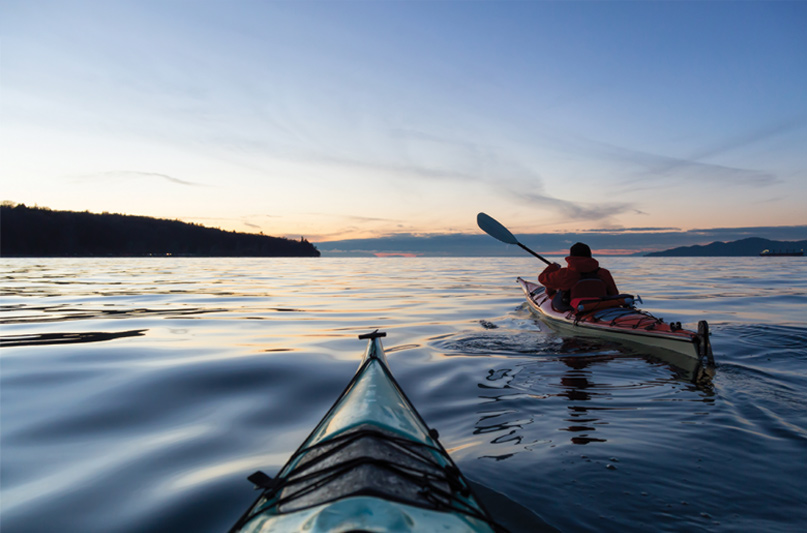
If boats are the cars of the water, then kayaks are the bicycles. Their easy-to-use, human-powered design make them perfect adventure companions. They require no permits or licenses, and are easier on your savings than a fuel-guzzling craft, and owning one can open doors to many wild spaces and epic places. Almost anyone can hop right in and have the basics figured out in a day, and it’s a skill you’ll likely never forget (like riding a bike). Whether you’re a boater without a boat or are simply curious about life on the water, kayaks are the perfect bridge from landlubber to sea salt for those looking to dip their fins in the watery scene.
When it comes to your ideal kayaking playground, the Pacific Northwest is the place to be. Sure, I might be a little biased, but with stunning alpine and city lakes, the lively Puget Sound, and the wild ocean all within paddles’ reach, it’s easy to find a spot for kayakers of every skill level. Why take a kayak instead of a bigger boat? The shallow nature of these personal watercraft offer a front row seat to experience nature’s wild ways firsthand in small coves and hidden inlets that larger boats can’t access.
Learning from an expert is always your safest, most reliable bet, which is why I’d recommend signing up for a class for your first kayaking experience. There are classes that focus on safety and communication, touring, racing, and more. Seattle Adventure Sports, for example, offers an intuitive Intro to Kayaking course for first-timers, but Director Don Cheyette tells me skill level isn’t a factor when it comes to booking one of their excursions. Sure, you can sign up for one of their intro courses, but you can also give them a call, express your adventurous itch, and Don and his team will work with you to create a custom trip that you’ll be stoked about.
Alki Kayak Tours is another option for kayakers of all levels. No experience is needed to paddle out on one of their sea kayaking tours. Explore the Alki Lighthouse, Elliott Bay, the Duwamish River, and the Olympic Mountains, or embark on the West Seattle Sunset Tour on one of our legendary summer evenings, or embark on an overnight camping tour to Blake Island, which includes gear and two meals.
To take it to an entirely new level, Pygmy Kayaks offer hands-on, week-long kayak building classes that’ll get you on the water in vessels you’ve built with your own two hands, but the on-water learning part is up to you.
Taking a class is a fantastic way to learn the basics quickly and forget about the logistics; i.e., you won’t have to worry about finding the right kayak for your desired activity or the necessary safety gear for your on-water adventure because the instructors have it covered. However, if you’re a learn-by-doing kind of person who likes to suss things out on your own, kayaking is one of those sports where it’s totally feasible.
If you decide to take the sport on yourself, invest in a comfortable PFD that doesn’t restrict arm movement while you’re paddling. There are specially made PFDs for kayaking, and many pros will advocate for standard (noninflatable) versions. Bring along a water bottle, a communication device like a VHF radio, strobe light, a paddle float, an EPIRB (emergency position-indicating radio beacon), and extra layers in a dry bag. We all know how quickly the temperature drops when the sun dips behind a cloud. For longer trips, bring along your favorite snack!
Before you paddle out, check the conditions including tides and wind direction, and prepare for the worst. Dress in bright colors to make yourself seen by other boaters. and if you’re out at night, NC Kayaks’ Susan Anderson likes to tie a lightweight, inflatable, solar-powered lantern like the Luci Outdoor lights to each end of her kayak to both be seen and to light her path. And lastly, tell your friend what you’ll be up to. These are called informal float plans and they act as a little safety net in worst-case scenarios. Kayaks are boats too, so remember those good boating habits.
The U.S. Coast Guard also requests that you label your kayak with contact info, just in case it gets away from you. An unidentified kayak floating by itself triggers a full-scale man overboard emergency response. You don’t want to explain that it was all an innocent misunderstanding to a helicopter pilot who spent all day looking for you.
Next time you find yourself with a glorious sunny day and could use a little vitamin sea, do yourself a favor and meander on down to one of our many waterfronts, rent yourself a kayak, and find a little on-water adventure on your own terms.


